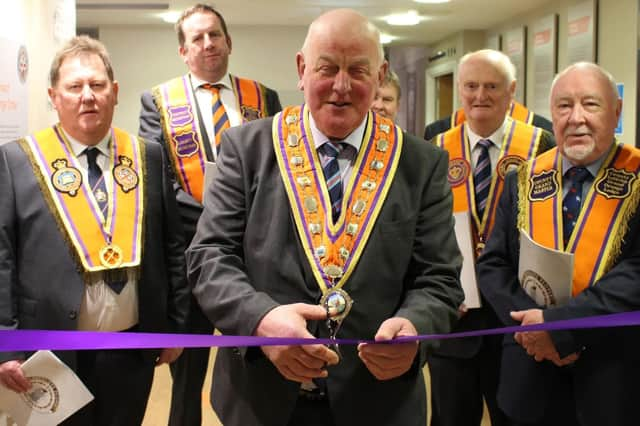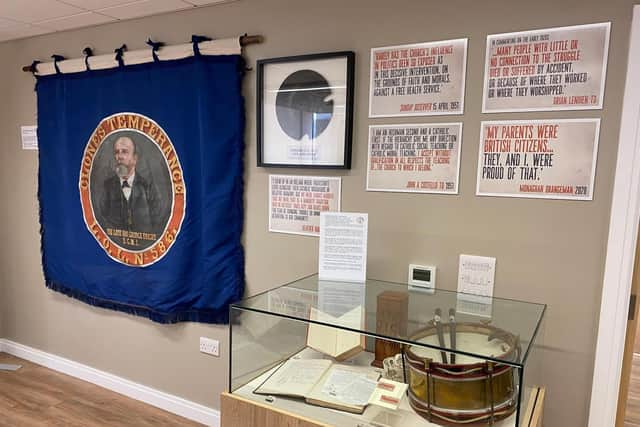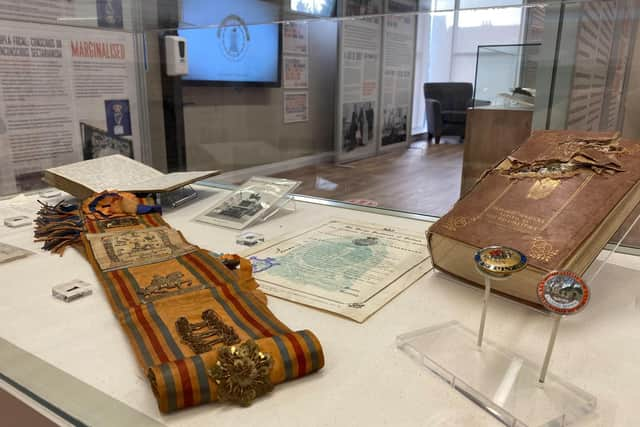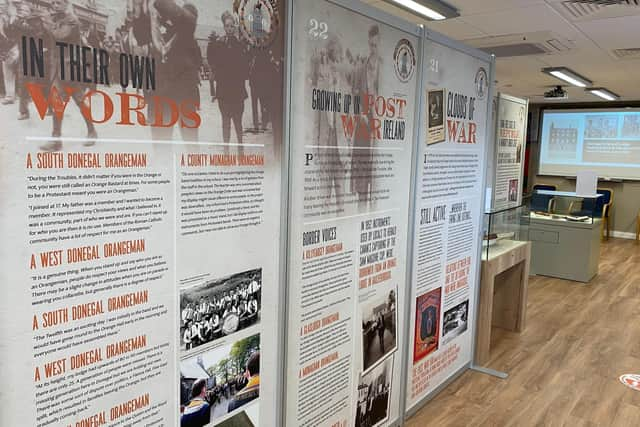‘Southern Protestants felt curtailed in celebrating their Orangeism following partition’


A new exhibition at the Museum of Orange Heritage at Shomberg House on Belfast’s Cregagh Road, focuses on the travails of brethren who were left in an embattled position following partition in 1921.
The Southern Protestants exhibition entitled ‘A Resolute People’, which was opened on February 7 by Grand Master Edward Stevenson, former Grand Master, the Reverend Mervyn Gibson, and a panoply of other senior members of the Order, has been put together by in-house curator and historian Dr Jonathan Mattison.
Advertisement
Hide AdAdvertisement
Hide Ad“This exhibition highlights the impact of partition and the creation of the Irish Free State in 1921 on the Southern Orange family,” said Jonathan.


“It was a major wrench for Orangemen below the border because as one leading Orangeman from Cavan in 1921 put it, a Major Saunderson, ‘Now I have no country’.
“This was a community that very much saw itself as British and part of the Unionist family who had been opposing Home Rule.
“The creation of Northern Ireland and the Irish Free State then left that community outside the United Kingdom.
Advertisement
Hide AdAdvertisement
Hide Ad“Previously, under the Act of Union, they had regarded their Irishness as a part of their Britishness. Now it was as though their identity was under siege.


“There was a huge sense of disappointment among brethren mixed with a real sense of anger in that they felt alienated within the new dispensation.
“They saw themselves as culturally British and felt left behind.”
Between 1911 and 1926 the Protestant population in the area that became the Irish Free State dropped by a dramatic 35 percent.
Advertisement
Hide AdAdvertisement
Hide Ad”There were significant periods of violence, intimidation and in some cases murder because the Protestant community were not seen as belonging and that sense of alienation and intimidation in some cases led to something of a mass exodus,” continued Jonathan.


These were turbulent times during the Anglo-Irish War of Independence, which raged between 1919 and 1921, and the Irish Civil War which continued between 1922 and 1923.
Ireland was in turmoil and Southern Protestants felt estranged from their fellow brethren once the border was imposed in 1921.
”Some republicans took great exception at the Protestant, loyalist and unionist population, because they did not regard them as Irish and you can understand how embattled their position was.
Advertisement
Hide AdAdvertisement
Hide Ad“After the new state was birthed, there was a strong sense that to be a valid Irish citizen you had to be nationalist, republican and Roman Catholic.”
The last loyal order celebrations below the border actually took place in 1931 when several of The Twelfth celebrations were attacked, so to prevent this kind of violence members of the Orange Order stopped holding their annual celebrations altogether in the border counties of the Republic.
In Monaghan, for some time, they had held Orange picnics, but Orangemen began to travel to Northern Ireland for their annual festivities as they began to regard it as being too dangerous to practice their cultural heritage below the border.
Today Rossnowlagh remains the only really significant celebration of Orangeism that does take place annually in the Republic, apart from a handful of Black Saturday celebrations.
Advertisement
Hide AdAdvertisement
Hide AdCurrently there are around 50 Orange Lodges around the border, with brethren travelling North for the Glorious Twelfth.
Dr Mattison talks about the immense hold that the Catholic Church in particular wielded over the new Irish Free State until its ideology became so overwhelmingly dominant that to be outside that orthodoxy became somewhat intimidating for Southern Protestants.
”The Young Ireland movement in the 1840s created the Irish tricolour which was supposed to symbolise peace between orange and green, or between Protestant and Catholic, but sadly in many cases it did not work out that way.
“The Dunmanway Massacre in Co Cork in April 1922 was one such egregious example, when 13 Protestants were murdered, one of whom was just a 16-year-old school boy, another was an 82-year-old pensioner, and these were certainly not people who could have been considered as being involved in anti-state activities.
Advertisement
Hide AdAdvertisement
Hide Ad“During the War of Independence the Irish Government did not have complete control and so unfortunately as a result you often found innocent Protestants being caught up in instances of violence and intimidation.”
Orange Order Headquarters had originally been located in Dublin before it was occupied by Sinn Fein in 1922.
Then headquarters were moved to Belfast that year and one of the items on display as part of the new exhibition is a biography of William Tyndale, a leading figure of the Reformation, that has a bullet hole in it.
This happened when anti-treaty forces occupying Orange headquarters in Dublin after Sinn Fein used whatever they could get their hands on to block the windows of the building while under siege.
Advertisement
Hide AdAdvertisement
Hide AdJonathan continued: “The whole ethos behind the exhibition is to remember and to give voice to the Southern Protestants who had felt so abandoned on the formation of the Irish Free State and the creation of Northern Ireland.
”We want to give voice to a community that has experienced so much over the past century.
“This was a community that felt set apart.
“You had Eamon de Valera coming out strongly in 1932 to say that the majority of people in Ireland were Catholic and that his government believed very strongly in Catholic principles.
“He said it was right and just that the principles his government would apply would be the principles of Catholicity.
Advertisement
Hide AdAdvertisement
Hide Ad“In 1935 he augmented that by declaring that: ‘Ireland has been a Christian and Catholic nation. She remains a Catholic nation and will not accept any system which denies or imperills that destiny.’”
The Orange Order became very important to Southern Protestants because it acted as a kind of glue, a network and a way of maintaining community with their Protestant neighbours.
”When the Ulster Unionist Council voted in 1919 to adopt partition and agree to a six county separation that left Southern Protestants behind, there was anger even at Edward Carson, who became a member of the Orange Order in his youth while studying at Trinity College,” adds Jonathan.
“And the Orange Hall became not only a place where brethren could celebrate their faith but also their cultural heritage and a place where they could connect with others in a community that felt so wrenched away from the Union and cut adrift and even betrayed by their brethren in what became Northern Ireland.”
Advertisement
Hide AdAdvertisement
Hide AdThe exhibition contains a narrative of the history laid out on colourful panels, with numerous photographs, artefacts, medals belonging to Orangemen, sashes, drums, banners and details of interviews with Southern Protestants from the 1920s through to the 1940s and right up to today.
But it is not a wholly negative story because these ‘Resolute People’ prevailed, they continued to be proud of their heritage and culture and the expansion of the Orange Order throughout the 19th century is also considered.
However there is no denying that as the 20th century progressed, Southern Protestants felt abandoned and their freedom to celebrate their Orangeism was sadly curtailed.
The Southern Protestants - A Resolute People exhibition is currently on display at the Museum of Orange Heritage at Schomberg House on Belfast’s Cregagh Road. It can be viewed from Monday to Saturday, 10am to 5pm (with last entry at 4pm).
A message from the Editor:
Advertisement
Hide AdAdvertisement
Hide AdThank you for reading this story on our website. While I have your attention, I also have an important request to make of you.
With the coronavirus lockdown having a major impact on many of our advertisers - and consequently the revenue we receive - we are more reliant than ever on you taking out a digital subscription.
Subscribe to newsletter.co.uk and enjoy unlimited access to the best Northern Ireland and UK news and information online and on our app. With a digital subscription, you can read more than 5 articles, see fewer ads, enjoy faster load times, and get access to exclusive newsletters and content. Visit https://www.newsletter.co.uk/subscriptions now to sign up.
Our journalism costs money and we rely on advertising, print and digital revenues to help to support them. By supporting us, we are able to support you in providing trusted, fact-checked content for this website.
Ben Lowry
Editor
Comment Guidelines
National World encourages reader discussion on our stories. User feedback, insights and back-and-forth exchanges add a rich layer of context to reporting. Please review our Community Guidelines before commenting.